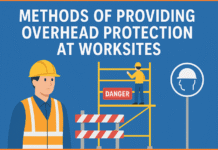Managing occupational health and safety is important and there is no doubt left that if businesses have to survive then organizations have to manage their occupational health and safety risks.
Contents
The next that comes in our mind is how we can effectively manage health and safety in our organization?
The answer lies in a simple management model known as the Deming cycle. This cycle is also known as the P-D-C-A cycle or the plan-do-check-Act cycle. It is a cycle which remains rotating continuously. It starts with:

- Plan: This involves setting up a target and planning of how it can be achieved.
- Do: This involves implementing the plan in a systematic way.
- Check: Periodically the targets set, needs to be checked whether they are been achieved or not and whether the results achieved are in line with the expectations.
- Act: This step closes the cycle indicating whether any improvements need to be made for any un-achieved targets and at the same time deciding on new targets, for those are achieved.
The above cycle is used in creating management systems like ISO 9001, ISO 14001 and OHSAS 18001.
ILO’s Occupational Safety and Health Management System
The key elements are:
- Policy (plan)
- Organizing (plan)
- Planning and implementation (Do)
- Evaluation (check)
- Auditing (check)
- Action for improvement (Act)
- Continual improvement (Act)
Policy: it is the statement of intent made by the top management showing their commitment with respect to aim and objectives in maintaining and practicing good safety and overall reducing accidents or even achieving zero harm.
Organizing: this element speaks about the roles and responsibilities of various levels towards health and safety, the delegation of authority, and channel of communication, within the organization, right from the MD to the assembly worker and also the staff.
Planning and implementation: This element will focus on detailed arrangements to do about achieving the targets set in the policy section. While policy speaks about ‘what needs to be achieved‘ these sections speak about ‘ how it can be achieved’. This section will have procedures for carrying out risk assessments, accident investigations, etc.
Evaluation – ( monitoring, Review, measurement, and investigation): this includes methods of the monitor and measures the performance. Some monitoring method could be proactive like for e.g. a safety tour, safety sampling, and safety survey while other could be reactive like for e.g. measuring accident, absenteeism and ill- health data.
Audit: it is planned, systematic and critical evaluation of the health and safety management system by a competent person. It will identify weaknesses and suggest changes in the health and safety management system implementation process or in the setting of inadequate or unrealistic targets. The audit will also ensure that the organization in this compliance with necessary legislation according to the nation and previous audit records.
Action for improvement: it is at this stage the result of monitoring are compared to the set objectives and targets. If the set targets are achieved. Then the enhanced target can be set for the future, but if targets are not met, then the organization need to evaluate the reason for non- achievement and take corrective and preventive action. It may be necessary to make changes either in the policy, organizing or the planning sections.
Continual improvement: The health and safety management system follow as a continuous cycle, it needs to continuously progress and achieve better and greater targets. The whole idea is not to remain static but to keep on continually improving.
OHSAS 18001 Model: (Occupational Health and Safety Assessment Series)
Even though there is much equality between ILO-OSH 2001 and OHSAS 18001, OHSAS 18001 is certifiable and valuable.
Policy (plan): policy is established by top management which demonstrates their commitment to explain the occupational health safety management system through the efficient and continuous improvement process and to minimize the financial losses.
Planning (plan): It is important for an organization to plan for the health safety objectives based on the legal framework which includes hazards identification, risk assessment, and appropriate control measures.
Implementation and Operation (Do): At this phase organizational structure should be defined along with the responsibilities of each segment like the top, senior middle, and junior management categories. Top management must demonstrate their commitment to consultation and communication, operational control, emergency preparedness and response, training and documentation.
Check and corrective action (Check): The performance measurement through active and reactive monitoring methods are the key components of this segment. The reactive monitoring method will help the organization to identify the cause of the accident, various non-conformance and the corrective methods whereas the active monitoring assist to follow the procedures to protect the people, equipment, materials, and environment. The safety audit is also an inevitable part of evaluating the safety performance.
Management review (Act): The higher management holds vital roles in reviewing the organization’s occupational health and safety performance records of the management system for suitability, adequacy, and effectiveness of the system. The review recommends the need for change in policy, planning, organizing, implementing or monitoring methods for improvements. The change must be properly documented for review and continual improvement is being measured.
Continual improvement (Act): OHSAS 18001:2007 Defines it as the “recurring process of enhancing the OH&S management system in order to achieve improvements in overall OH&S performance consistent with the organization’s OH&S policy”.
why the policy is made?
- Employer commitment in respect of health and safety.
- Legal requirement.
- It provides motivation for to employees.
- To show the benchmark with the similar industries.
- To satisfy client or customer and public.
- Aim and objective of the organization.
- Will influence to the decision made by an organization.





